Crane Hawk
A species of Crane hawk Scientific name : Geranospiza caerulescens Genus : Crane hawk
Crane Hawk, A species of Crane hawk
Botanical name: Geranospiza caerulescens
Genus: Crane hawk
Content
Description General Info
 Photo By jerryoldenettel , used under CC-BY-SA-2.0 /Cropped and compressed from original
Photo By jerryoldenettel , used under CC-BY-SA-2.0 /Cropped and compressed from original Description
The crane hawk (Geranospiza caerulescens) is a species of bird of prey in the family Accipitridae. It is monotypic within the genus Geranospiza. 
Size
51 cm
Nest Placement
Tree
Feeding Habits
Crane Hawk primarily consumes small vertebrates and invertebrates, including rodents, bats, lizards, and snakes. It also feeds on frogs, nestlings, large arthropods, molluscs, and occasionally fruit. It has specialized feeding behaviors, with the ability to extract prey from cavities using its double-jointed legs and elongated toes.
Habitat
Crane Hawk's habitat spans diverse lowland environments including dry semi-deciduous forests, rainforests, and mangrove systems. This bird species typically frequents areas with aquatic features and adapts to both natural and human-modified landscapes. Optimal habitats are characterized by forests with dense understories and irregular canopies, usually at elevations below 500 meters.
Dite type
Carnivorous
General Info
Feeding Habits
Bird food type
Behavior
These hawks often forage by scanning from a perch or on the wing and swooping down to grab prey. However, they are notable for having “double-jointed” tarsal bones, allowing them to reach into tree cavities and extract prey, a trait they share only with the genus of African harrier-hawks Polyboroids. Their main prey are small vertebrates, especially rodents, bats, lizards, snakes, and small birds, but they have also been known to eat larger insects and other arthropods and snails. During breeding, nests are built in tree canopies, often in clumps of orchids or other epiphytes. The nest is a shallow cup of twigs, anywhere from 10–25 metres up in a tree. Clutches are usually 1-2 white-or-bluish-tinged eggs. 
Distribution Area
Crane hawks occur in tropical lowlands at the edge of forests and are almost always closely associated with water. It is found in Argentina, Belize, Bolivia, Brazil, Colombia, Costa Rica, Ecuador, El Salvador, French Guiana, Guatemala, Guyana, Honduras, Mexico, Nicaragua, Panama, Paraguay, Peru, Suriname, Trinidad, Uruguay, and Venezuela. They are an irruptive and local migrant, probably moving in response to changing water conditions. 
Species Status
Nowhere is the crane hawk particularly common, but it is still widely distributed. However, it is considered threatened in Mexico, endangered in El Salvador, and at low risk in Argentina. 